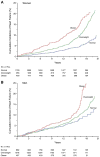Cardiac remodeling in obesity
- PMID: 18391168
- PMCID: PMC2915933
- DOI: 10.1152/physrev.00017.2007
Cardiac remodeling in obesity
Abstract
The dramatic increase in the prevalence of obesity and its strong association with cardiovascular disease have resulted in unprecedented interest in understanding the effects of obesity on the cardiovascular system. A consistent, but puzzling clinical observation is that obesity confers an increased susceptibility to the development of cardiac disease, while at the same time affording protection against subsequent mortality (termed the obesity paradox). In this review we focus on evidence available from human and animal model studies and summarize the ways in which obesity can influence structure and function of the heart. We also review current hypotheses regarding mechanisms linking obesity and various aspects of cardiac remodeling. There is currently great interest in the role of adipokines, factors secreted from adipose tissue, and their role in the numerous cardiovascular complications of obesity. Here we focus on the role of leptin and the emerging promise of adiponectin as a cardioprotective agent. The challenge of understanding the association between obesity and heart failure is complicated by the multifaceted interplay between various hemodynamic, metabolic, and other physiological factors that ultimately impact the myocardium. Furthermore, the end result of obesity-associated changes in the myocardial structure and function may vary at distinct stages in the progression of remodeling, may depend on the individual pathophysiology of heart failure, and may even remain undetected for decades before clinical manifestation. Here we summarize our current knowledge of this complex yet intriguing topic.
Figures




References
-
- Aasum E, Belke DD, Severson DL, Riemersma RA, Cooper M, Andreassen M, Larsen TS. Cardiac function and metabolism in Type 2 diabetic mice after treatment with BM 17.0744, a novel PPAR-alpha activator. Am J Physiol Heart Circ Physiol. 2002;283:H949–H957. - PubMed
-
- Aasum E, Cooper M, Severson DL, Larsen TS. Effect of BM 17.0744, a PPARalpha ligand, on the metabolism of perfused hearts from control and diabetic mice. Can J Physiol Pharmacol. 2005;83:183–190. - PubMed
-
- Aasum E, Hafstad AD, Severson DL, Larsen TS. Age-dependent changes in metabolism, contractile function, and ischemic sensitivity in hearts from db/db mice. Diabetes. 2003;52:434–441. - PubMed
-
- Abe Y, Ono K, Kawamura T, Wada H, Kita T, Shimatsu A, Hasegawa K. Leptin induces elongation of cardiac myocyte and causes eccentric left ventricular dilatation with compensation. Am J Physiol Heart Circ Physiol. 2007;292:H2387–H2396. - PubMed
-
- Abel ED. Insulin signaling in heart muscle: lessons from genetically engineered mouse models. Curr Hypertens Rep. 2004;6:416–423. - PubMed
Publication types
MeSH terms
Substances
Grants and funding
LinkOut - more resources
Full Text Sources
Other Literature Sources
Medical

